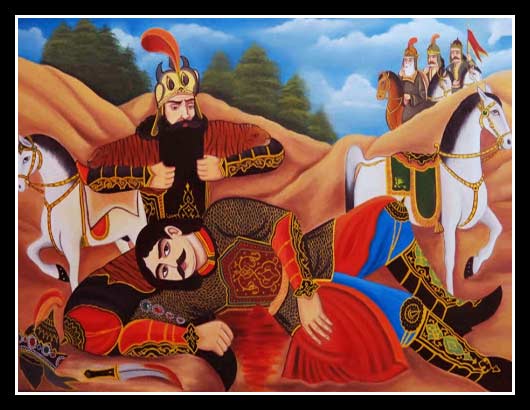Introducing the Coffee House Painting School.
About the Iranian folk art painting or Ghahve-Khaneh:

The Ghahve khane style painting developed separately from the formal and academic arts and grew in contrast to the Iranian academic and miniature painting styles.
This style of painting is a kind of folk-narrative painting that is contemporary with the constitutional movement and based on Iranian traditions, customs, folk and religious arts have been created, which finally became a style of folk painting and narration in the Pahlavi period.
Researchers in the field of painting consider the history of folk and religious painting in Iran to be related to the Safavid dynasty. For example, in the murals of Imam Zadeh Zayd in Isfahan, scenes of Imam Hussein’s taziyeh are depicted.
These paintings are very different from the space of court art of that period, and only in drawing and depicting the clothes of people in these paintings can we see a slight reflection of the space of the Safavid court.
It is certain that over the past few centuries, a variety of paintings from rural and popular culture have developed in parallel with the formal and court art of society, but Ghahve khane painting has undergone a different process and style.
This style of Iranian painting, which expresses nationalism, religious beliefs, and the spirit of the particular culture of the middle classes of urban society, is a newer style than other forms of folk painting in Iran.
The stories of Ferdowsi’s Shahnameh and Khamseh Nezami, religious events and folk tales are the main themes of coffee house painting, and based on these themes and narrative stories, they were first formed in the artist’s mind and finally painted on a large curtain.
Perhaps the coffee house painting can be considered the first origin and basis of this style of Iranian painting, because the owners of coffee houses were among the first to order this painting.
However, ghahve khane paintings were hung not only in cafes, but also in zurkhaneh, baths and other places. Of course, the subject of each curtain was the painting that determined the place of installation.
Artists of coffee house painting arose from various occupations such as tiling, plastering, building painting, etc. And because of their personal interest and only experimentally, these artists also learned the art and technique of oil painting.
The coffee house painting artist uses his personal styles and tastes in the painting and wants to be able to influence ordinary people with a simpler and clearer expression. Of course, visual narration never stopped the painter from imagining and allegorizing.
The Ghahve Khane painting artist portrayed and painted the scenes of the painting in a free style without copying the real model. And so they chose the imaginative painting style for their paintings to distinguish them from other painters, who had a realist style.
The coffee house painting artist always tends to portray scenes of battle and display the outward and inward characteristics of man, and this is due to his beliefs about the conflict between the forces of evil and good.
And the painter, with the same moral, doctrinal beliefs, and according to the narrative logic of his paintings, observes certain principles in his method and style for drawing bodies and clothes, coloring and composition.
Therefore, coffee house painting does not have aesthetic principles and certain rules compared to schools such as the Qajar painting style. Also in this style of Iranian painting, the artist uses less the rules and principles of Western painting such as: perspective, volume and realism style.
The coffee house painting was developed with artists such as Hossein Qollar Aghasi and Mohammad Modbar, and this style of painting also influenced the art of contemporary Iranian painting.
They raised students such as Fathollah Ghoul, Hossein Hamedani, Hassan Ismailzadeh-Chelipa and Abbas Blockifar, who continued this style in their painting.
Today, this style of folk and narrative painting is no longer used in contemporary Iranian painting, and with the entry of modern art into today’s life, we can see it less, and unfortunately the style of the Ghahve Khane or coffee house painting has been gradually forgotten.
© Fa.asadi Artwork Collection.
